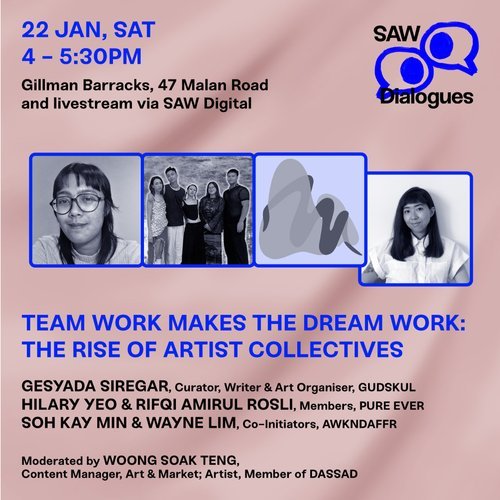SAW Dialogues 2022 | In Retrospect: 10 Years of SAW
Emi Eu, Low Eng Teong, Magnus Renfrew, Ning Chong
By Wan Jie Che
Screenshot of talk. From left to right: Ning Chong, Founder, The Culture Story, Emi Eu, Executive Director, STPI – Creative Workshop & Gallery Singapore and Project Director, S.E.A. Focus, Low Eng Teong, Deputy Chief Executive Officer, National Arts Council, Magnus Renfrew, Founder of ARTHQ Group, Co-Founder of ART SG
Key points:
Connectivity is key to a successful Art Week.
A good balance between the digital and the physical aspects of Art Week is important.
Increased involvement of stakeholders, including institutions, will engender more connection with the public through art.
‘In Retrospect: 10 Years of SAW’ took place at Mandala Club on 21 January 2022 from 2.30pm. Emi Eu, Executive Director of STPI – Creative Workshop & Gallery Singapore, Project Director of S.E.A. Focus; Low Eng Teong, Deputy Chief Executive Officer of National Arts Council; and Magnus Renfrew, Founder of ARTHQ Group and Co-founder of ART SG gathered to reflect on the past ten years of Singapore Art Week (SAW). They discussed how Art Week has evolved during the pandemic and shared their hopes for the future of Art Week. The panel discussion was moderated by Ning Chong, Founder of The Culture Story.
Here are the takeaways from the panel:
The indicators of a successful Art Week is unique to each stakeholder in the art market. Ning, who was involved in the early editions of Singapore Art Week, prompted the panellists to share their definition of a successful Art Week. To Magnus, the three basic principles are quality activities, geographical diversity and accessibility. He elaborated that visitors have the intention of experiencing art from different cultures, especially cross-cultural collectors. He would like visitors to feel involved in Art Week activities, regardless of whether they have the intention of collecting artworks or if they are simply there to experience international art.
For Eng Teong, the focus of Art Week is to build a successful art ecosystem and outlined three indicators of success: the connection of people and communities locally and internationally, the contribution of Art Week to building the economy, and the establishment of Singapore as a livable and lovable city. Extensive surveys on local and international participants have been conducted over the years to evaluate the impact of Art Week. It covers soft indicators, such as the value of art to individuals, and hard indicators, quoting the number of activities and visitorship numbers as an example.
Emi reiterated the points raised by Magnus and Eng Teong. She added that to her, a successful Art Week is the culmination of different stakeholders and the cultivation of new and pre-existing personal and professional relationships through the event. She emphasised the importance of being physically present to forge these relationships in the art scene, for which Art Week provides a platform.
While the digital aspects of the art market have risen in popularity, the physical experience remains key for Art Week. Hence, stakeholders will need to balance both aspects moving forward. Using the discussion on NFTs as a springboard, the panellists contemplated on the evolution of the digital space, how it will change the way individuals view and appreciate art and the potential of seeing more NFT artworks in the next Art Week.
Magnus acknowledged that NFTs will play a key part in the art ecosystem as traditional galleries are increasingly featuring artworks of that medium and there would then be more NFT artworks in future Art Weeks. He also shared that there will be a sector dedicated to digital art, which will include it. He also suggested that there needs to be a critical understanding of NFTs such as how artists are exploring the medium and how they examine the human condition through it, a point that Emi concurred with given that it is still in its nascent stages.
In response to the Emi and Magnus’ discussion, Eng Teong summarised that the future of the art market will see a coexistence of the digital and physical spheres and therein lies the challenge of balancing the two modes of presentation.
The panelists hope to see a greater involvement of more stakeholders in Art Week, a larger pool of international audience, and to continue to connect the public and communities through art. Emi commended the involvement of Singapore Art Museum (SAM) in SAW 2022 that effectively brought the entire art ecosystem together and hoped that there would be continued involvement of key art market players. Magnus would like to see a more global audience and the inclusion of international curators in discovering the region from a curatorial perspective. While there has been some involvement of organisations from the private sector, Eng Teong aspires to elicit greater participation from them. He concluded the discussion on an optimistic note by sharing the inception of the SAW acronym, which is about seeing, and encouraged all the stakeholders to stay true to their mission of promoting the local art scene.
Watch the full recording of ‘SAW Dialogues 2022 | In Retrospect: 10 Years of SAW’ here:
About the writer:
Wan Jie Che is a contributor based in Singapore with a background in Economics and Art History. She is currently working in the financial sector and has interests in cultural economics, the art market, sustainability and innovation in organisations. In her spare time, she also volunteers at a local community arts space with programming, strategy and management.















